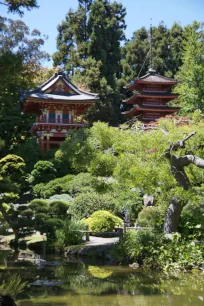Located in San Francisco’s Golden Gate Park, the harmonious Japanese Tea Garden is one of the park’s most popular attractions. The garden is decorated with beautiful statues and structures, including a large pagoda.
History of the Garden
Midwinter Fair of 1894

San Francisco’s first Japanese Tea Garden was originally developed by art-dealer George Turner Marsh as part of the 1894 Midwinter Fair, an event that brought the City by the Bay into the international limelight. About forty are (one acre) in size, this garden was intended only for the exposition – as were many of Golden Gate Park’s other structures – and was to be dismantled after the fair.



A Permanent Exhibit
One of San Francisco’s most prominent Japanese citizens, Baron Makoto Hagiwara, a wealthy landscape designer, asked the city if he could make the garden permanent. They agreed. Hagiwara devised a traditional design not unlike the gardens in his native country and turned the small garden into a two-hectare (five-acre) permanent exhibit complete with exotic animals, statues, and other structures important to the make-up of a classic Japanese garden.
Decline and Restoration
The garden was maintained by Hagiwara and his descendants until World War II, at which time the landscaper’s family was moved to one of the many interment camps built to house Japanese-Americans during the turbulent war years. During that era, the garden became known as the Oriental Tea Garden. In 1952, the original name was restored and so was the garden, which had fallen into ruin during the absence of the Hagiwara family.
The Garden Today
Today, the Japanese Tea Garden is an important and much-visited part of the Golden Gate Park and attracts tens of thousands of visitors each year.
In Japan, gardens are considered the highest form of art and great thought was put into the design of this garden. With winding paths, a number of water features, bridges, and – of course – plants and trees, the garden promotes a feeling of tranquility.
The main pond is surrounded by dwarf trees, and a magnificent Buddha sits near the Long Bridge. The Sunken Gardens are adorned with stone lanterns and rhododendron and the Zen Garden – a dry landscape – is a miniature mountain scene with stone waterfall and white gravel river.
A colorful pagoda sits in the center of the garden near the Temple Gate, surrounded by a traditional rock garden, and the Teahouse beckons guests to come and enjoy a quiet moment and a warm beverage. (By the way, fortune cookies became popular here!)

